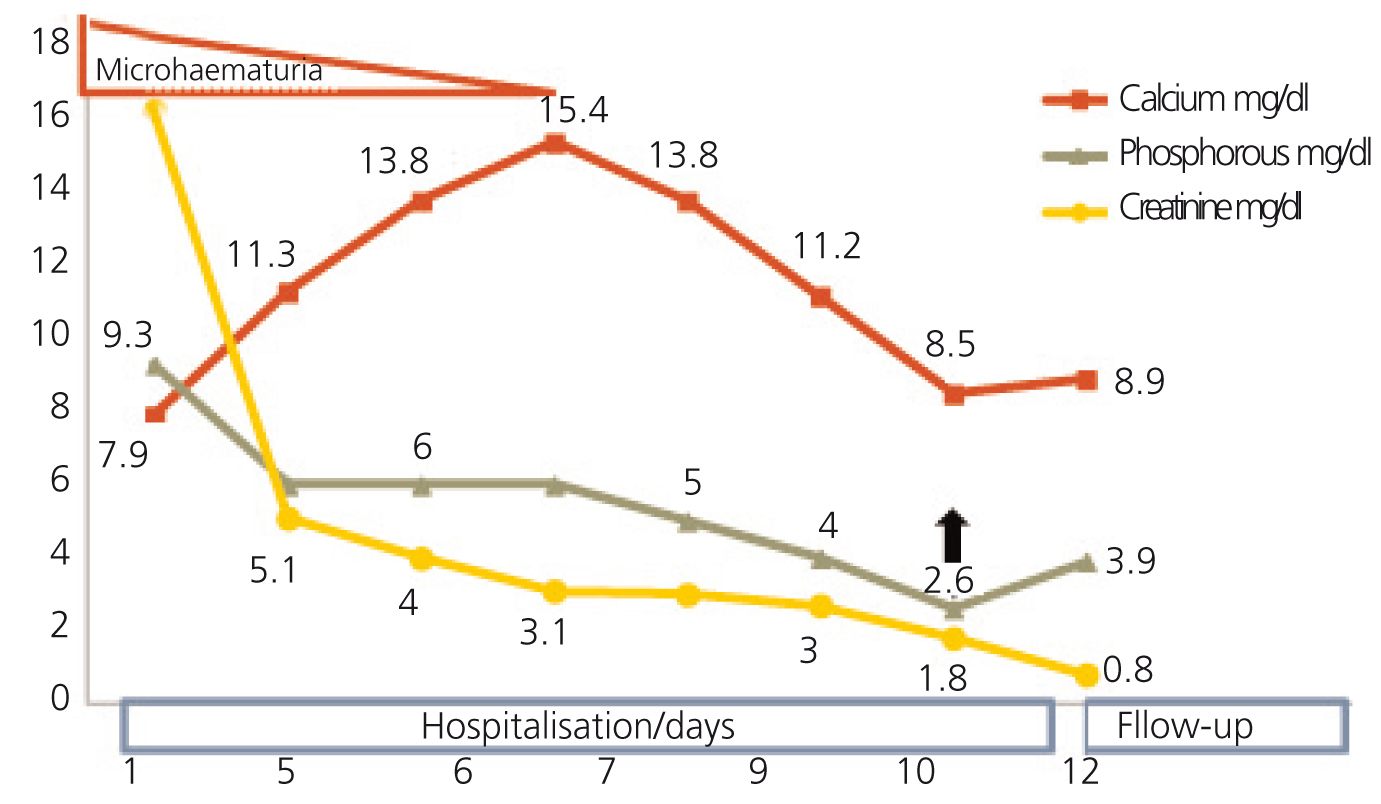To the Editor:
Rhabdomyolysis (RD) is the process of cellular necrosis in striated muscle, with the release of intracellular components into the blood stream.1
Acute renal failure (ARF) appears in 15%-50% of cases of RD, and can be associated with altered calcium metabolism with a biphasic pattern. In the initial oliguric phase, 60% of patients with RD can develop hypocalcaemia.2 In the recovery phase of ARF, 20%-30% can develop hypercalcaemia.3
The cases described in the literature of RD with hypercalcaemia equal to or greater than 15mg/dl correspond to patients that initially suffered severe hypocalcaemia.3-7
Here we present the case of RD secondary to intense exercise during grape harvest and associated with ARF, in which, following a mild initial bout of hypocalcaemia, the patient developed severe hypercalcaemia at 15.4mg/dl.
Our patient was a 21-year-old male with no relevant medical background. Fifteen days prior to hospitalisation, the patient started to suffer general malaise, muscle pain, vomiting, swelling of the legs, and dark urine followed by oligoanuria, following intense exercise during grape harvest. The patient’s primary physician started treatment with prokinetics, muscle relaxants, and antibiotics (norfloxacin), with no improvement. A physical examination revealed skin and mucosae dehydration and bradypsychia. The patient’s blood pressure was 150/60mm Hg, with a soft abdomen that produced slight pain upon deep palpation. The muscles in the limbs were hardened, and all other results were normal.
A laboratory analysis revealed: creatinine: 16.2mg/dl; urea: 411mg/dl; maximum creatinine phosphokinase (CPK): 1000U/l; total protein: 6.3g/dl; albumin: 3.9g/dl; Na: 134mEq/l; K: 4mEq/l; Ca: 7.9mg/dl; P: 9.3mg/dl. A urine analysis revealed red blood cells +++ and urinary sediment: 7-8 red blood cells/field (Figure). Viral serology (for hepatitis B and C and human immunodeficiency virus) was negative. Chest x-ray and abdominal ultrasound results were normal.
Given the patient’s severe state of nitrogen retention and symptoms indicative of uremic encephalopathy, we administered two sessions of haemodialysis, intense hydration therapy, and urine alkalinisation. This produced improvements in the clinical symptoms and laboratory results. Despite this improvement, the patient continued to suffer vomiting on the seventh day of treatment; we performed more tests, observing hypercalcaemia at 15.4mg/dl. We administered intense hydration therapy, diuretic treatment, calcitonin, and bisphosphonates. Parathyroid hormone (PTH) levels were 7.97pg/ml, and 25-dihydroxyvitamin D was at 22nmol/l. Upon discharge, the patient’s creatinine level was 1.8mg/dl, CPK was normal, and serum Ca was at 8.5mg/dl. In later follow-up sessions, creatinine was at 0.8mg/dl and Ca and CPK values were with normal ranges (Figure).
Reviewing the medical literature, we can observe more than 60 cases published since 1970 of hypercalcaemia associated with RD.3-9 We can also note that the majority of cases described of hypercalcaemia >15mg/dl, such as in our case, initially present severe hypocalcaemia.3-7 Our patient had mild hypocalcaemia at 7.9mg/dl during the oligoanuric phase, and later developed hypercalcaemia at 15.4mg/dl. In a similar manner, Grobety et al. described two cases of patients with mild hypocalcaemia during initial phases of RD, at 7.4mg/dl and 7.6mg/dl, who later developed severe hypercalcaemia at 15.6mg/dl and 15mg/dl, respectively.10
Hypocalcaemia in RD tends to appear in the oliguric phase of ARF, is normally temporary, and can occasionally be severe and symptomatic. Treatment with calcium salts and/or vitamin D derivatives should be avoided, since this could aggravate the state of hypercalcaemia produced in the recovery phase of RD.9 Our patient did not require treatment, since the hypocalcaemia was mild and asymptomatic.
Hypercalcaemia in RD tends to occur in the phase of recovery of diuresis in the associated ARF; this is primarily due to the release of calcium deposited in the muscles into the bloodstream, along with mild hyperparathyroidism caused by renal failure.4,9 The majority of cases of hypercalcaemia are self-limiting, and may only need observation and adequate hydration.2 However, certain patients require treatment with bisphosphonates, calcitonin, and loop diuretics,2 as in our case.
Our patient did not require sequential PTH measurements during hospitalisation, but during the phase of recovery from diuresis, he did develop severe hypercalcaemia with suppressed PTH, as in the majority of described cases. However, calcitriol levels were normal, in contrast with the low levels described by other authors.3,4
To conclude, the majority of cases of ARF associated with RD and severe hypercalcaemia initially present the form of severe hypocalcaemia, and occasionally mild hypocalcaemia. We described a case of severe hypercalcaemia in a patient with an initial mild decrease in calcium levels. This suggests that severe hypercalcaemia following mild hypocalcaemia might be the result of approaching the case of RD when it was already substantially progressed, or due to outside factors. Our case may have been one of late RD, although we cannot confirm this, since we do not have laboratory analyses from before the patient was hospitalised. However, when presented with a patient with ARF and RD, we must monitor calcium kinetics alterations, even when serum calcium levels in the initial phase are normal or only slightly low.
Conflicts of interest
The authors have no conflicts of interest to declare.
Figure 1. Evolution of calcium, phosphorous, and creatinine levels during hospitalisation and after discharge







